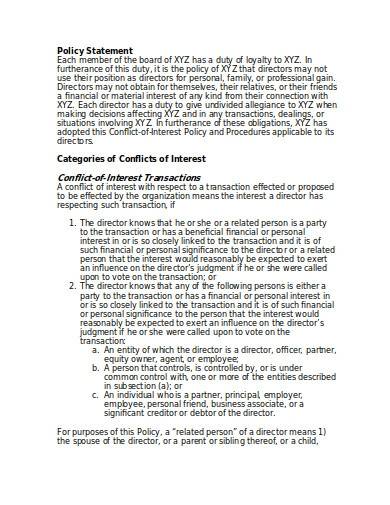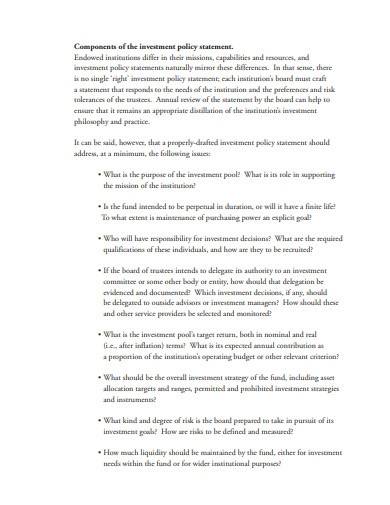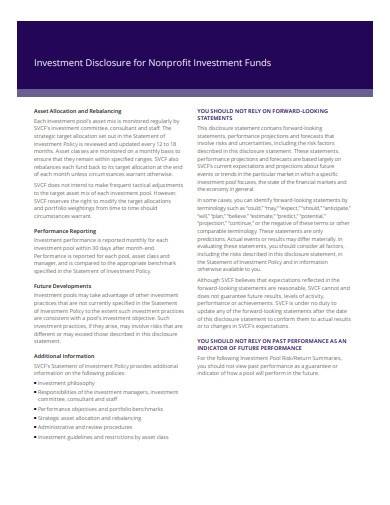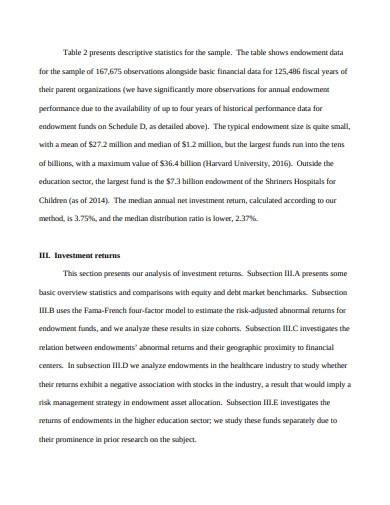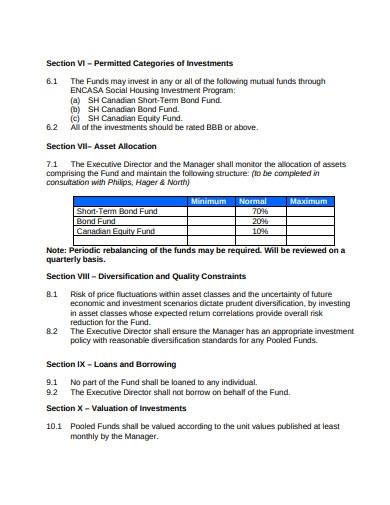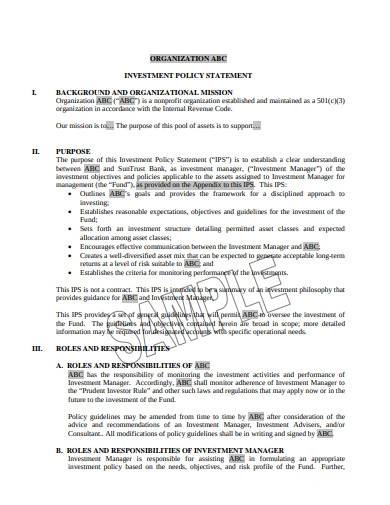Investment policies are descriptions of parameters for the investment of government funds and identifying investment objectives, risk tolerance, constraints on investment portfolios, and the method of how investment programs are going to be managed and tracked. This policy provides an improvement in the quality of the decision-making process as well as demonstrates a commitment to the reasonable management of public funds. An investment policy for charities or nonprofit organizations serves as their company roadmap, guiding them through their investment programs and specifying their risks as well as determining the business goals they want to achieve.
FREE 5+ Charity Investment Policy Samples & Templates in MS Word | PDF
1. Charity Investment Policy Template
2. NGO Investment Policy Template
3. Nonprofit Investment Funds Policy
4. Investment Returns & Distribution Policy
5. Charity Housing Association Investment Policy
6. Nonprofit Organisations Investment Policy
What is a Charity Investment Policy?
Nonprofit or charitable organizations heavily depend on donations they receive from donors and grantors and it is common for most of these organizations to invest some portion of this in stocks, bonds, and other investments to develop their financial status. An effective investment policy for nonprofits is able to achieve its goals and objectives as well as incorporate systems and procedures to protect its directors and board members. Other policies for charities include the charity privacy policy, charity marketing policy, charity recruitment policy, donation policy, charity expenses policy, and more.
How to Create Charity Investment Policy
Investment policy statements are created to outline the general rules that a manager must follow as well as the general investment goals and objectives of a certain client. It also provides a description of strategies that the said manager should follow to achieve their investment objectives. Investments require careful monitoring and effective financial planning requires the organization’s board to allocate an efficient amount of funds for its operations and short-term use.
Step 1: Determine Your Investment Goals
Document your investment goals by quantifying and prioritizing them. Quantify how much you will need for your investment and take advantage of tools to help you come up with an estimate of your investment goal amount.
Step 2: Create an Outline for Your Investment Strategy
Your investment strategy is a set of principles that will aid you in achieving your financial goals as well as investment goals. This strategy depends on different factors such as financial situations, goals, personal situations, expected returns, and more.
Step 3: Document Your Current Investment and Target Asset Allocation
This section refers to the documentation of all your accounts of a particular type and their most recent values. Investments can be set on certain allocations such as US stocks, bonds, foreign stocks, and more.
Step 4: Be Specific in Your Monitoring Parameters
Your monitoring parameters refer to how often you will check up on your investment portfolio. The maximum frequency of checking is monthly and must also include an outline of the time when you will rebalance.
FAQs
What are the common sections in an investment policy statement?
Investment policy statements commonly include sections such as an introduction, scope of work, roles and responsibilities of parties involved, investment objectives, time horizon, attitude to risk and capacity for capital loss, liquidity requirements, ethical policy, eligible asset classes, performance benchmarks, restrictions, management, reporting, and monitoring, and approving and reviewing.
What should be considered when adopting investment policies?
If you want to adopt investment policies, you should consider first whether they can protect the value of your initial invested assets, ensure that the investment’s value will increase, and whether board members can access the assets in case of potential cash flow issues.
What are the benefits of investment policy statements?
With investment policy statements, investors are provided with a foundation for all their future investment decisions, provides them with guidelines, identifies their goals, and provides a systematic review process.
What are the elements used as a guide for writing an effective investment policy?
To write an effective investment policy, you must consider its purpose, delegation of responsibilities, responsibilities of the board, responsibilities of the oversight committee, responsibilities of the management, guidelines for investing, performance measurement standards, expenditures of institutional funds, donor restrictions, and reserve fund expenditures.
Some of the most critical aspects for charitable organizations that affect their stability and viability are their portfolio management plan and investment policy. A charity investment policy statements document that outlines a nonprofit organization’s investment goals and objectives as well as the description of the investment strategy it will be used to meet them, containing specified information on areas like asset allocation, liquidity requirements, and risk tolerance.
Related Posts
FREE 10+ Charity Mission Statement Samples and Templates in MS Word | PDF
FREE 10+ Charity Pay Policy Samples & Templates in MS Word | PDF
FREE 10+ Charity Privacy Policy Samples & Templates in MS Word | PDF
FREE 10+ Charity Standing Order Form Samples & Templates in MS Word | PDF | MS Excel
FREE 10+ Charity Risk Management Policy Samples & Templates in PDF
FREE 3+ Charity Investment Strategy Samples & Templates in PDF | MS Word
FREE 5+ Charity Marketing Policy Samples & Templates in PDF
FREE 5+ Charity Recruitment Policy Samples & Templates in MS Word | PDF
FREE 3+ Charity Management Accounts Samples & Templates in PDF
FREE 10+ Charity Gift Aid Form Samples & Templates in MS Word | PDF
FREE 10+ Charity Strategy Samples & Templates in MS Word | PDF
FREE 6+ Charity Marketing Strategy Samples & Templates in MS Word | PDF
FREE 10+ Charity Financial Policy Samples & Templates in MS Word | PDF
FREE 10+ Charity Financial Policies and Procedures Samples & Templates in MS Word | PDF
FREE 10+ Charity Expenses Policy Samples & Templates in MS Word | PDF

